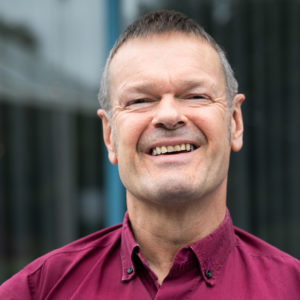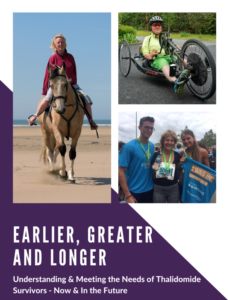Future Care Costs Report
In focus: Earlier, Greater, Longer report published from the Thalidomide Trust's Future Care Costs project
 Graham Kelly
Graham Kelly
In the March Directors’ Update, you were advised that a short report of the long-running Current & Future Care Costs project had been published and was available on the Trust website (with a printed copy available on request). This project investigated the additional needs that Thalidomiders have and will increasingly have in the future, and to estimate associated costs.
The original idea for the project came from the NAC. It was then carried out by Trust staff with the help of specialist experts. The aim was to obtain clear and robust evidence to show to Diageo and the governments that fund the Health Grant, demonstrating that our needs, and associated costs, will increase as we age, and consequently more funding will be needed.
Beneficiaries provided vital evidence for the project
The evidence we put together came from two sources, and all data was treated with strict confidentiality. Firstly, with the help of an expert statistician the study used data from the Holistic Needs Assessments (HNAs) that most beneficiaries have with a member of staff from the Trust. So, thank you, to everyone who has had a HNA, because you made and continue to make an important contribution. Secondly, from 16 'exemplar' cases where volunteer beneficiaries were assessed in great detail to identify the current and future needs. I’d like to say a massive thank you to the 16 for volunteering to do this.
These 16 were chosen to make sure they represented the full range of impairments across our beneficiary community. In other words, whatever your particular thalidomide-caused impairments, at least one of the 16 had similar impairments to yourself.
External experts were commissioned for assessments and data analysis to establish a model for costs
The 16 assessments were carried out by Bush & Co, one of the UK’s leading Assessors and Expert Witnesses in personal injury cases. They identified the support that those 16 beneficiaries would need and estimated the likely costs - now and in the future. For example, 8 hours of care per week now may change to 20+ hours per week in 10 years’ time.
Bush & Co’s financial figures were cross-referenced with data from HNAs to create a set of realistic assumptions and the resulting figures were then rigorously reviewed by Hugh Gregory, a Forensic Accountant, to make sure they were robust and to create a model showing how the costs could be applied across the whole beneficiary community . Hugh is a leading name in this field and has calculated personal injury costs in many famous cases. One such case was the compensation payments for the Birmingham Six.
The assessment was comprehensive. On top of social care needs, it considered the cost of everyday living expenses. Transport, holidays, pet care, household decoration, home adaptations, entertainment, health treatments and pretty much everything that we pay money for.
What will now happen with the report?
 The information obtained from this study has given the Trust a much clearer understanding of the current and future needs across our beneficiary community although, at this stage the future costs are very much best estimates. There is currently a high degree of uncertainty and the current figures are based on judgements about how quickly the needs of beneficiaries will change over time and the rate at which different costs will increase. However, very importantly, the study has given us a 'model' with which we can estimate the cost of future needs. As we continue to gather evidence from future HNAs and have a clearer picture of the likely future cost of things like treatment and care, we can re-run the model to make sure we are always on top of your changing needs and costs.
The information obtained from this study has given the Trust a much clearer understanding of the current and future needs across our beneficiary community although, at this stage the future costs are very much best estimates. There is currently a high degree of uncertainty and the current figures are based on judgements about how quickly the needs of beneficiaries will change over time and the rate at which different costs will increase. However, very importantly, the study has given us a 'model' with which we can estimate the cost of future needs. As we continue to gather evidence from future HNAs and have a clearer picture of the likely future cost of things like treatment and care, we can re-run the model to make sure we are always on top of your changing needs and costs.
Prior to having this any estimation of needs and costs was largely guess-work. Now we have a sophisticated model that can be built on and improved in the future. This will be valuable when we talk to our funders because they will see that we have a solid justification for money we ask for in the future.
Read the report on the Trust website (Note: You will need to log in to see this information.)
